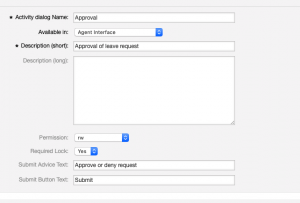Conform to international standards; use OTRS for Process Management
Shawn Beasley04. Feb 2019 | Best PracticesConsultingUse casesUser Experience
Disclaimer:
The practical examples presented in our technical blog (blog.otrs.com) and now in the expert category in our FAQ blog section serve as a source of ideas and documentation to show what is theoretically possible with OTRS in concrete scenarios or sometimes even for more exotic configurations. All configurations presented here were developed under laboratory conditions as a proof of concept.
We can only guarantee testing and implementation of these concepts to be error-free and productive if implemented in a workshop with one of our OTRS consultants. Without this, the responsibility lies with the customer himself. Please note that configurations from older OTRS versions may not work in the newer ones.
The Back Story
Business Process Model and Notation, BPMN for short, allows you to visualize the process model. A process model, written in BPMN, is an XML file at its heart. This XML format is well defined and maintained by the Object Management Group. This XML is deigned for portability, to be executable, and is currently the leading industry standard format (ISO/IEC 19510:2013). Business Process Management Suites (BPMS) and other tools use this to exchange processes. This means that most of these tools can read and or generate BPMN. Read how OTRS is leveraging this standard.
When designing a process, it should be clear to business users what is happening. This means the tasks involved and the performers are graphically represented. BPMN 2.0 has an entire library of standardized visual elements and terminology which OTRS leverages now to better conform to this standard.
BPMN describes the following two objects (narrowing it down a bit ;)) which OTRS is has adopted.
Task Objects: User, Script, Service (others not currently addressed)
Sequence Flow
In ((OTRS)) Community Edition, you have the possibility to configure:
Activities
Activity Dialogs
Transitions
Transition Actions
Automation of the workflow takes place in the transition and transition actions.
In OTRS, we now talk about
Task Activities
User Task Activity Dialogs
Sequence Flows
Sequence Flow Actions
So far no big change. We see now that OTRS uses the standard names for two elements vs. re-inventing the wheel. This makes it easier for your business team to talk with the OTRS administrators and makes integration tasks much easier. The real magic comes when we create a Task.
A Task in ((OTRS)) Community Edition is always a User Task.
A Task in OTRS can be a User, Script, or Service Task.
This means, that you can now visualize all of the elements of automation within the process manager canvas. Based on the user input of any Task, the Sequence Flow will determine the next Task. Changes in ticket data done via a Script Task (or specially programmed functions like Sending an Email), or calls to foreign systems via a Service Task, are not only presented to the process designer for ease and speed of design and troubleshooting, but notification of such tasks are now seen by agents when the system is performing them, or during errors.
Task Wokring
Taks Failed
A fully visual process, only with OTRS.
We still have some tool specifics which we will be adapting to support the standard better in the future, but for now: Service Desk Management Automation has never been easier and more compliant that with OTRS.




Shawn Beasley at 01.10.2019, 10:10
You need to look in the print version of the process for the process ID and the activity ID. Then you can add these to the generic agent as edit ticket data.
Nosy at 01.10.2019, 09:18
Hello I need help. I want a certain ticket coming in to trigger a process ticket automatically. How do I configure that in the genericAGent and the Process itself?